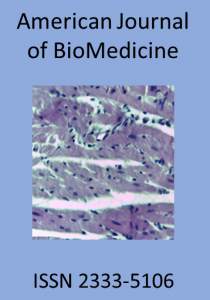Abstract
Endometrial cancer is the most common gynecologic malignancy. There is increasing evidence suggesting that S100P has a significant role in cancer. The objective of this study is investigate the role of S100P in promote endometrial cancer cell proliferation and S100P has received increasing attention due to accumulating evidence of its significant role during the development and progression of different cancers. Quantitative real-time RT-PCR (qPCR) analysis was used to measure changes of S100P. Transwells is used for migration and invasion assay respectively. Cell proliferation was analysed by flow cytometry. High expression of S100P are associated with invasion endometerial cancer while, knockdown of S100P protein decreased cellular proliferation and migration. In conclusion, S100P regulate endometrial cell proliferation migration and invasion and reduces chemoresistance.
Keywords: Endometrial cancer; S100P; Quantitative real-time RT-PCR
Copyright © 2019 by The American Society for BioMedicine and BM-Publisher, Inc.
- Miller KD, Siegel RL, Lin CC, et al. Cancer treatment and survivorship statistics, 2016. CA Cancer J Clin. 2016;66(4):271-289. https://doi.org/10.3322/caac.21349
PMid:27253694 - Ryan AJ, Susil B, Jobling TW, et al. Endometrial cancer. Cell Tissue Res 2005;322:53-61.
https://doi.org/10.1007/s00441-005-1109-5
PMid:15947972 - Creasman, W. T. et al. Carcinoma of the corpus uteri. FIGO 26th Annual Report on the Results of Treatment in Gynecological Cancer. Int J Gynaecol Obstet 95(Suppl 1), S105-143.
https://doi.org/10.1016/S0020-7292(06)60031-3 - Lu, L, Shen, Y, Tseng, K‐F, Liu, W, Duan, H, Meng, W. Silencing of UCA1, a poor prognostic factor, inhibited the migration of endometrial cancer cell. Cancer Biomark. 2016; 17( 2): 171‐ 177.
https://doi.org/10.3233/CBM-160628
PMid:27540975 - Liu H, Shi J, Anandan V, Wang HL, et al. Reevaluation and identification of the best immunohistochemical panel (pVHL, maspin, S100P, IMP3) for ductal adenocarcinoma of the pancreas. Arch Pathol Lab Med. 2012;136:601-9.
https://doi.org/10.5858/arpa.2011-0326-OA
PMid:22646265 - Arumugam T, Simeone DM, Schmidt AM, Logsdon CD. S100P stimulates cell proliferation and survival via receptor for activated glycation end products (RAGE) J Biol Chem. 2004;279:5059-5065.
https://doi.org/10.1074/jbc.M310124200
PMid:14617629 - Eritja N, Yeramian A, Chen BJ, Llobet-Navas D, Ortega E, Colas E, Abal M, Dolcet X, Reventos J, Matias-Guiu X. Endometrial carcinoma: specific targeted pathways. Adv Exp Med Biol. 2017;943:149-207.
https://doi.org/10.1007/978-3-319-43139-0_6
PMid:27910068 - Lin F, Shi J, Liu H, et al. Diagnostic utility of S100P and von Hippel-Lindau gene product (pVHL) in pancreatic adenocarcinoma-with implication of their roles in early tumorigenesis. Am J Surg Pathol. 2008;32:78-91.
https://doi.org/10.1097/PAS.0b013e31815701d1
PMid:18162774 - Dowen SE, Crnogorac-Jurcevic T, Gangeswaran R, et al. Expression of S100P and its novel binding partner S100PBPR in early pancreatic cancer. Am J Pathol. 2005;166:81-92.
https://doi.org/10.1016/S0002-9440(10)62234-1 - Koyuncuoglu, M. et al. Tumor budding and E-Cadherin expression in endometrial carcinoma: are they prognostic factors in endometrial cancer? Gynecol Oncol 125, 208-213.
https://doi.org/10.1016/j.ygyno.2011.12.433
PMid:22198340 - Zhao, Y, Yang, Y, Trovik, J, et al. A novel Wnt regulatory axis in endometrioid endometrial cancer. Can Res. 2014; 74( 18): 5103‐ 5117.
https://doi.org/10.1158/0008-5472.CAN-14-0427
PMid:25085246 - Yousif NG. Fibronectin promotes migration and invasion of ovarian cancer cells through up‐regulation of FAK-PI 3 K/A kt pathway. Cell biology international 2014;38:85-91.
https://doi.org/10.1002/cbin.10184
PMid:24115647 - Kumar D, Gokhale P, Broustas C, Chakravarty D, Ahmad I, Kasid U. Expression of SCC-S2, an antiapoptotic molecule, correlates with enhanced proliferation and tumorigenicity of MDA-MB 435 cells. Oncogene. 2004;23(2):612-616.
https://doi.org/10.1038/sj.onc.1207123
PMid:14724590 - Rauh-Hain, J. A. & Del Carmen, M. G. Treatment for advanced and recurrent endometrial carcinoma: combined modalities. Oncologist 15, 852-861.
https://doi.org/10.1634/theoncologist.2010-0091
PMid:20660059 PMCid:PMC3228028 - Yousif NG, Al-Amran F, Hadi N, Lee J, Adrienne J. Expression of IL-32 modulates NF-κB and p38 MAP kinase pathways in human esophageal cancer. Cytokine 2013;61:223-227.
https://doi.org/10.1016/j.cyto.2012.09.022
PMid:23107826 - Filipek A, Jastrzebska B, Nowotny M, Kuznicki J. CacyBP/SIP, a calcyclin and Siah-1-interacting protein, binds EF-hand proteins of the S100 family. J Biol Chem. 2002;277:28848-28852.
https://doi.org/10.1074/jbc.M203602200
PMid:12042313 - Singh, M. et al. ZEB1 expression in type I vs type II endometrial cancers: a marker of aggressive disease. Mod Pathol 21, 912-923. https://doi.org/10.1038/modpathol.2008.82
PMid:18487993 - Gotzmann J, Mikula M, Eger A, et al. Molecular aspects of epithelial cell plasticity: implications for local tumor invasion and metastasis. Mutat Res 2004;566:9-20.
https://doi.org/10.1016/S1383-5742(03)00033-4 - Wang DG, Yousif NG, Sadiq AM, et al. Critical role of SEMA5A expression in invasion and metastasis of ovarian cancer cell. American Journal of BioMedicine 2014;2(3):292-305.
https://doi.org/10.18081/2333-5106/014-03/292-305 - Cirisano FD, Jr, Robboy SJ, Dodge RK, et al. Epidemiologic and surgicopathologic findings of papillary serous and clear cell endometrial cancers when compared to endometrioid carcinoma. Gynecol Oncol. 1999;74:385-94.
https://doi.org/10.1006/gyno.1999.5505
PMid:10479498 - Price FV, Amin RM, Sumkin J. Complete clinical responses to neoadjuvant chemotherapy for uterine serous carcinoma. Gynecol Oncol. 1999;73:140-4. doi: 10.1006/gyno.1998.5303.
https://doi.org/10.1006/gyno.1998.5303
PMid:10094895 - de Boer SM, Powell ME, Mileshkin L, et al. on behalf of the portec Study Group. Adjuvant chemoradiotherapy versus radiotherapy alone for women with high-risk endometrial cancer (portec-3): final results of an international, open-label, multicentre, randomised, phase 3 trial. Lancet Oncol. 2018;19:295-309.
https://doi.org/10.1016/S1470-2045(18)30079-2 - Usach I, Blansit K, Chen LM, et al. Survival differences in women with serous tubal, ovarian, peritoneal, and uterine carcinomas. Am J Obstet Gynecol. 2015;212:188.e1-6.
https://doi.org/10.1016/j.ajog.2014.08.016
PMid:25149685 - Yousif NG, Sadiq AM, Yousif MG, Al-Mudhafar RH, Al-Baghdadi JJ, Hadi NR. Notch1 ligand signaling pathway activated in cervical cancer: poor prognosis with high-level JAG1/Notch1. Archives of Gynecology and Obstetrics 2015;292:899-904. https://doi.org/10.1007/s00404-015-3694-1
PMid:25842263 - Batista TP, Cavalcanti CL, Tejo AA, Bezerra AL. Accuracy of preoperative endometrial sampling diagnosis for predicting the final pathology grading in uterine endometrioid carcinoma. Eur J Surg Oncol. 2016;42:1367-71.
https://doi.org/10.1016/j.ejso.2016.03.009
PMid:27052799
3. Purchase this article at rate $33.00
For any technique error please contact us
Who Can Become a Reviewer?
Any expert in the article's research field can become a reviewer with American Journal of Biomedicine. Editors might ask you to look at a specific aspect of an article,...
How to cite this article
Jonathan A. Serody, Kerry R. Russell, Rui Chen, Mark B. Ferrara. Over expression of IL-32β- exaggerated myocardial injury after ischemia and reperfusion in mice model. American Journal of BioMedicine 2021;9(1):76-100.
Research Article
1. Abstract
2. Keywords
3. Introduction
4. Methods
5. Results
6. Discussion
7. References


